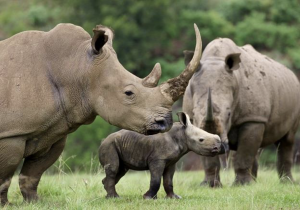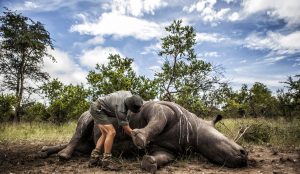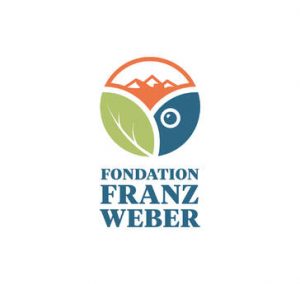By Michael Eustace (Investment analyst) [email protected].
The South African Cabinet, after a long process of opinion gathering, has decided not to put a proposal to CITES (The Convention on International Trade in Endangered Species), on rhino horn trade. Why?
The Minister, Edna Molewa, at a media briefing recently, said that it was not because of a fear of losing the vote at the CITES CoP (Conference of the Parties) to be held in September. Nor was it sensitivity around proposing a controversial issue at CoP, which South Africa is to host and where we would like to be hospitable.
As a country, we are not sure of exactly how much horn stock we have and mischief makers like to use that as an indication of inherently weak governance which weakness suggests that we could not manage a proper, well controlled, trade. The Minister saw that as a minor issue.
A clear idea of how we intend to trade and the absence of a trading partner was a more substantial issue. The Department of Environmental Affairs (DEA) has had several years to decide on a trading model and has seen a paper by me on a “Smart Trade” model which was published in Business Day in July, 2014, and was widely supported. That model involves a monopoly of supply selling to a cartel of retailers in the Far East, which cartel could include some of the Traditional Chinese Medicine hospitals that are owned by Far Eastern governments. The cartel would establish a clear channel for legal horn and incentivise Far Eastern governments to close down the illegal trade as, by design, they would be invested in the legal trade.
There was confusion around whether SA had to name their trading partners as part of the proposal. It was widely talked about as being a problem but CITES in Geneva have told me that it is not a requirement. One would like to think that China and Vietnam would be happy to trade with us if CITES first agrees to a trade proposal? Why should they prefer an illegal trade?
There was “considerable uncertainty” in Cabinet as to how successful trade would be at reducing poaching. Well, the ban on trade has been a failure with over a thousand rhino being poached each year. Could trade be worse? On the contrary, trade would reduce the number killed because trade will satisfy the market with legal horn gathered from natural deaths, from stocks and from the harvesting of a relatively small number of rhino. (The horn re-grows.) South Africa could satisfy the market, on a sustainable basis, without the need to kill one rhino. A controlled high price would limit demand.
Cabinet were worried about who would control the trade and who would profit. The “Smart Trade” model suggested a Central Selling Organisation (CSO) that would belong to the SA government and to governments of any other African range states that wanted to participate but the suggestion was that an experienced trading entity should be hired to manage the trading for a small commission of, say, 3% of turnover. That would have resulted in 97% of the income going back to parks and to the private ranchers. There was probably jealousy that the private owners would benefit from trade but they have had the costs of caring for the rhino and will be taxable in the normal way. Private ranchers own 33% of SA’s rhino.
Corruption was another concern. “Smart Trade” does not allow for any corruption. The CSO only pays the state and provincial parks and the Private Rhino Owners Association and nobody else. (Cynics have
suggested that the lack of possibilities for corruption was more likely to have been the problem!)
Then there was the illogical requirement from Cabinet that before trade could be considered in the future, 5 key requirements had to be met:
1) Increased security: but trade will reduce poaching by supplying the market and there will be funding to pay for security. Horn trade would generate R2 billion p.a. Security now costs R1.2 billion p.a. and there is no income.
2) Profits for communities: but these profits are only possible with trade and not with a ban on trade. Given trade, parks can enter into joint ventures with the communities in buffer zones around the parks.
3) Biological management (needs to improve): but we have been managing rhino populations for 50 years and are really good at it. Given trade we can populate other parks in Africa with rhino and make these parks financially viable.
4) Laws need to be (more effectively) enforced: but recently there has been a large increase in convictions with a 78% success rate and the sentences have been severe. That is a great improvement which will improve further with lower levels of poaching. Filling jails should not be an ambition.
5) We need to know how to manage demand: but there are only 1 million consumers that currently buy the total annual supply of 1,300 horns and there are probably another 1 billion existing TCM consumers in the queue, at lower prices. Managing demand, other than through the price mechanism, is futile. There is nothing more to know.
These requirements cannot possibly be the prerequisites of trade. They are either advantages that will only come from trade or are irrelevancies.
They seem to be an attempt to justify the time as not being right for trade.
The wording in the media release was tortuous–perhaps the work of many trying to instil logic into an illogical decision. The Minister comes across as sincere and smart and energetic. It is difficult to believe that her heart can be in the outcome. She said there was a “genuine desire” to take all the issues to Cabinet but they found them “too wide” (to comprehend) and so decided to do nothing about a trade proposal. A two page document might have produced a different result?
In my opinion, South Africa has missed the conservation opportunity of a lifetime.



